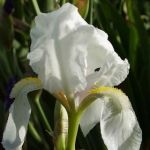| Common Name: |
Orris |
| Botanical Name: |
Iris Germanica var. florentina syn. I.florentina. |
| Genus: |
Iris |
| Family: |
Iridaceae |
| Cultivation: |
Well-drained, neutral to alkaline soil in sun (I. germanica var. florentina); rich, moist to wet, acid soil or shallow water in sun (I. versicolor). |
| Propagation: |
By seed sown in autumn or spring; by division or offsets in summer. Cultivars may not come true from seed. |
| Harvest: |
Rhizomes are lifted in the late summer and early autumn, and dried for use in decoctions, liquid extracts, and powders. |
| Native Location: |
E. Mediterranean |
| Height: |
60cm-1.2m (2-4ft) |
| Width: |
Indefinite |
| Hardiness: |
Z4-10 |
| Parts Used: |
Rhizomes |
| Properties: |
A soothing, aromatic herb that has diuretic and expectorant effects. It is both purgative and anti-diarrheal. |
| Medicinal Uses: |
Internally for coughs, mucus and diarrhea. Externally for deep wounds. |
| Culinary Uses: |
Rhizomes are sometimes included in the N African spice mixture, ras el hanout. |
| Economic Uses: |
Added to dental preparations, breath fresheners, and dusting powders. Used as a fixative in perfumery and potpourris. Essential oil is used to flavor soft drinks, gin, and chewing gum, and to enhance fruit flavors. |
| Warning: |
All parts of Iris species, especially rhizomes, are harmful if eaten. Skin irritant and allergen. |
| Bibliography: |
Encyclopedia of Herbs by Deni Brown. Copyright © 1995, 2001 Dorling Kindersley Limited. pg. 244
|

